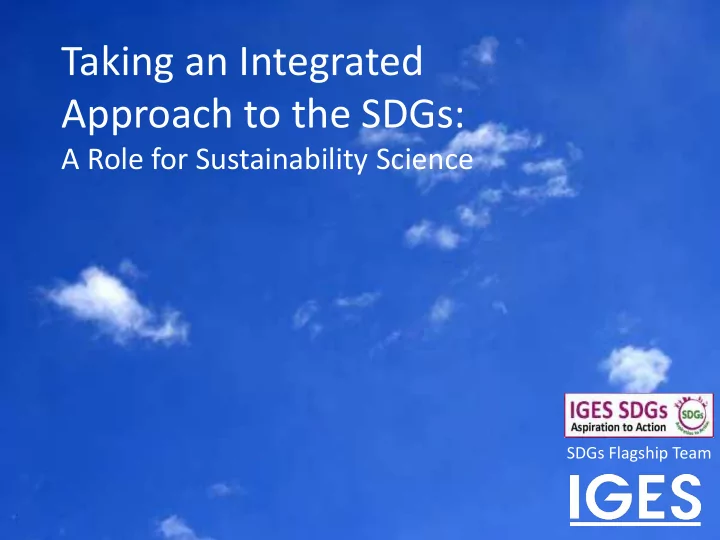

Taking an Integrated Approach to the SDGs: A Role for Sustainability Science SDGs Flagship Team
Outline 1. Why an integrated approach? 2. An integrated approach across and within the SDGs 3. Carrying forward an integrated approach
1. Why an integrated approach?
The problem: sustainability crises
UNCHE 1972: the world works towards solutions
Since 1970s: growing number of environmental agreements
Also growing amount of national legislation Source: MIT, 2004
Local governments more active on global environmental issues Source: Reckien, 2013
Words Action Implementation Gaps
The Sustainable Development Goals
The SDGs: 1. Universal 2. Transformational 3. Integrated
2. An integrated approach across and within the SDGs
Table of Contents Chapter 1: Introduction to Governance for the SDGs Part 1: Cross- Chapter 2: Governance for the MDGs cutting Chapter 3: Trends in Governance for Sustainable Development Chapter 4: Accountability for Financing the Post-2015 Agenda Chapter 5: Education in the Sustainable Development Agenda Part 2: Sector Specific Chapter 6: The Role of Water Security Chapter 7: The Role of Water Security Chapter 8: The Multiple Benefits of an Energy SDG Chapter 9: Conclusions on Integrated and Inclusive Governance
Chapter 2: Governance for the MDGs Regulatory Controls on Quality Corruption Government Rule of Law Effectiveness Voice and Political Accountability Stability
Chapter 3: Trends in Sustainable Development Governance References to compliance References to collaboration 1.20% 0.60% 1.00% 0.50% 0.80% 0.40% 0.60% 0.30% 0.20% 0.40% 0.10% 0.20% 0.00% 0.00%
Chapter 8: The Multiple Benefits of an Energy SDG 1. Access 2. Efficiency 3. Renewables 4. Reduction/lifestyle
3. Carrying forward an integrated appraoch
1 2 Inter Act 4 SDG 11 13 14 15 16 17 IGES Homepage Data & Analysis Methodology Simulation Publications Impressum Urban Targets Ecological Footprint Food-Water-Energy Nexus
InterAct on SDGs: Data & Analysis Select Countries: GOAL & COUNTRY SELECTION HOME Methodology Data & Analysis Simulation Publications Urban Targets Ecological Footprint Food-Water-Energy Nexus SOCIAL NETWORK ANALYSIS & DATA TABLE TABLES Philippines 1 2 3 Select All 2000 2001 2002 2003 2004 2005 2006 2007 2008 2009 2010 2011 2012 17 Goals 4 6 7 5 1 6 6 6 6 6 6 6 6 6 6 6 6 6 8 9 10 2 6 6 6 6 6 6 6 6 6 6 6 6 6 11 12 13 14 3 6 6 6 6 6 6 6 6 6 6 6 6 6 15 16 17 4 6 6 6 6 6 6 6 6 6 6 6 6 6 1 TARGETS Target 1.1 By 2030 increase per capita teddy bear distribution to Indicator 1 Indicator 2 Target 1.2 Reduce the impact of dark forces in the solar sys…. 2 INDICATOR Selected indicators S X Indicator 1 Household teddy bear survey X Indicator 2 xxxx X Indicator 3 xxxx Export Data: 3 4
Gender and Climate Finance
2012 2013 2014/15 ADB RETA7914 1) Focused stakeholder consultations 1) Initiate policy dialogue Harnessing 2) Help climate agencies and women’s groups Climate Change 2) Begin capacity development collaborate (i.e. MAFF Gender and Children’s Working Group and MOE in Mitigation Cambodia and MoNRE and Laos Women’s Union in Lao PDR ) Initiatives to 3) Analyze policy landscape Benefit Women 3) Support mainstreaming gender into climate policies 4) Plan gender sensitive pilot projects 4) Implement gender sensitive pilot projects 5) Assist with development of gender sensitive climate finance proposal
Asian Co-benefits Partnership www.cobenefit.org • A platform to improve information sharing and stakeholder dialogue on co-benefits in Asia. • Goal: to support the mainstreaming of co- benefits into decision- making processes in Asia.
Recommend
More recommend